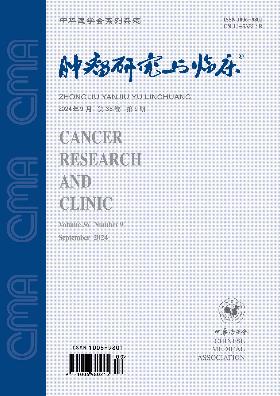人工智能辅助诊断模型在乳腺结节超声诊断中的应用价值
Q4 Medicine
引用次数: 0
摘要
目的探讨基于卷积神经网络(CNN)的人工智能辅助诊断模型在乳腺良恶性结节超声鉴别诊断中的应用价值。方法利用基于cnn的人工智能辅助诊断模型,从首都医科大学附属北京同仁医院超声图像数据库中检索2006年12月至2017年7月1 351例乳腺结节患者的7 334张超声图像,其中良性807例,恶性544例。该研究包括训练子集(6 162张图像)、验证子集(555张图像)和测试子集(617张图像),在人工智能辅助诊断模型中进行。将诊断模型试验亚群结果与病理结果进行比较。计算人工智能辅助诊断模型的灵敏度、特异性和准确性。结果617张图像检测后,模型诊断结果可自动输出,并以矩形框显示结节位置、良恶性诊断、良恶性概率值。每个结节的诊断时间约为4秒。诊断模型鉴别乳腺良恶性结节的敏感性、特异性和准确性分别为84.1%、95.0%和91.2%。结论基于cnn的人工智能辅助诊断模型在乳腺良性结节与恶性结节的鉴别诊断中取得了满意的结果,具有广阔的应用前景。关键词:乳腺肿瘤;卷积神经网络;人工智能;辅助诊断本文章由计算机程序翻译,如有差异,请以英文原文为准。
Application value of artificial intelligence-assisted diagnosis model in ultrasound diagnosis of breast nodules
Objective
To explore the application value of the convolutional neural network (CNN)-based artificial intelligence-assisted diagnosis model in the ultrasound differentiation diagnosis of benign and malignant breast nodules.
Methods
A total of 7 334 ultrasound images from 1 351 patients with breast nodules including 807 benign cases and 544 malignant cases were retrieved by using the CNN-based artificial intelligence-assisted diagnosis model from Beijing Tongren Hospital of Capital Medical University ultrasound images database between December 2006 and July 2017. The study included training subset (6 162 images), verification subset (555 images), and test subset (617 images), which were performed in the artificial intelligence-assisted diagnosis model. The outcome results of test subset in diagnosis model were compared with the pathological results. The sensitivity, specificity and accuracy of the artificial intelligence-assisted diagnosis model were calculated.
Results
After the test of 617 images, the model diagnostic results could be automatically output with a rectangular frame indicating the nodule position, benign and malignant diagnosis, benign and malignant probability values. The diagnosis time was approximately 4 seconds for each nodule. The sensitivity, specificity and accuracy of the diagnostic model in differentiating benign and malignant breast nodules were 84.1%, 95.0% and 91.2% , respectively.
Conclusion
The CNN-based artificial intelligence-assisted diagnosis model has satisfactory results in the differentiation diagnosis of the benign breast nodules and the malignant ones, which indicating the promising application prospect.
Key words:
Breast neoplasms; Convolutional neural network; Artificial intelligence; Auxiliary diagnosis
求助全文
通过发布文献求助,成功后即可免费获取论文全文。
去求助
来源期刊

肿瘤研究与临床
Medicine-Oncology
CiteScore
0.10
自引率
0.00%
发文量
7737
期刊介绍:
"Cancer Research and Clinic" is a series of magazines of the Chinese Medical Association under the supervision of the National Health Commission and sponsored by the Chinese Medical Association.
It mainly reflects scientific research results and academic trends in the field of malignant tumors. The main columns include monographs, guidelines and consensus, standards and norms, treatises, short treatises, survey reports, reviews, clinical pathology (case) discussions, case reports, etc. The readers are middle- and senior-level medical staff engaged in basic research and clinical work on malignant tumors.
 求助内容:
求助内容: 应助结果提醒方式:
应助结果提醒方式:


